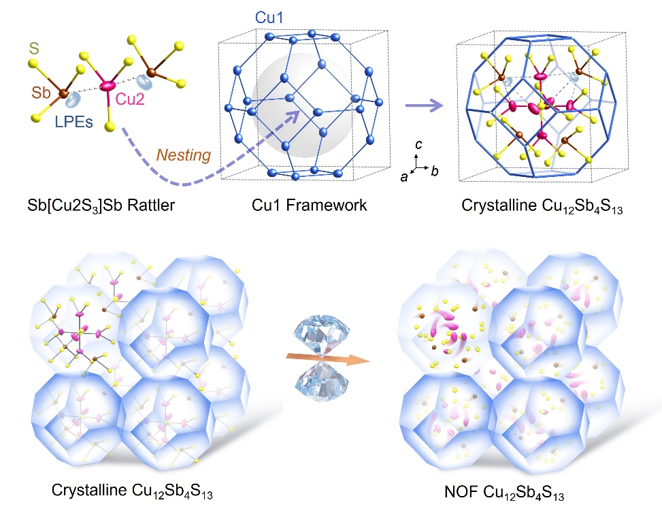A new crystalline-amorphous hybrid structure is found under pressure – Dr. Xujie Lü
AUGUST 10, 2022
Integrating the advantages of crystalline and amorphous states by creating hybrid structures has long been pursued. Recently, a research team led by Dr. Xujie Lü from the Center for High Pressure Science and Technology Advanced Research (HPSTAR) reports the discovery of a new crystalline-amorphous hybrid structure under pressure. Their study, entitled “Nested order-disorder framework containing a crystalline matrix with self-filled amorphous-like innards”, is published in the latest issue of Nature Communications.
Solids can be generally categorized by their structures into crystalline and amorphous states with different interactions among atoms. Crystalline-amorphous hybrid structures, combining the advantages of both ordered and disordered components, present a promising opportunity to design new materials with emergent collective properties. The structural design at the sublattice level of crystalline-amorphous hybrid materials with long-range periodicity is rewarding yet still challenging.
"Hybridization of crystalline and amorphous structures at mesoscopic scale has made great progress, while the hybridization at the sublattice level with long-range periodicity has rarely been observed.” said by Dr. Lü. “To this end, we propose a strategy to regulate the chemical-bond hierarchy of crystals that would enable the design of hybrid structures based on different sublattices”.
To realize the designed hybrid structure, the researchers selected a nested copper chalcogenide Cu12Sb4S13 which possesses a strong chemical-bond hierarchy. Using pressure to tune the bonding hierarchy, a nested order-disorder framework (NOF) constructed by a crystalline matrix with self-filled amorphous innards is obtained. “Lone-pair electrons (LPEs) in Sb cations play a significant role. An enhanced electrostatic repulsive force from LPEs shoves part of Cu atoms away from the equilibrium position which gives rise to the disordered sublattice, but the rest crystalline framework retains.” explained by the first author, Dr. Kejun Bu, a postdoctoral fellow at HPSTAR.
Interestingly, the NOF Cu12Sb4S13 simultaneously achieves a low lattice thermal conductivity and a metallic electrical conductivity, realizing the collaborative improvement of two competing physical properties.

Caption: llustration of the Cu12Sb4S13 structure with chemical-bond hierarchy and the formation of nested order-disorder framework (NOF).
根据原子排列方式的不同可以将固体物质分为晶体、准晶和非晶。晶态和非晶态的材料各具优势,如何获得晶体-非晶杂化材料来集成这两种状态的结构和性质特点是理解其内在相互作用机制的关键、也是新材料设计开发的重要方向。近日,北京高压科学研究中心(HPSTAR)吕旭杰研究员带领的研究团队报道了一种新的晶体-非晶杂化材料。通过压力调控Cu12Sb4S13晶体内在化学键键级,实现了亚晶格尺度上有序-无序嵌套的框架结构。研究团队采用多种高压原位实验技术和理论计算,揭示了该结构在一个晶体学单胞中包含自填充的无定形Cu基亚晶格和坚固的晶体框架,该框架具有长程有序性。有趣的是,这种新的有序-无序杂化材料兼具极低的导热率和高的导电性,成功实现了两种互为竞争物理性质的协同提升。相关工作以“Nested order-disorder framework containing a crystalline matrix with self-filled amorphous-like innards”为题发表于近期的《自然-通讯》上。
